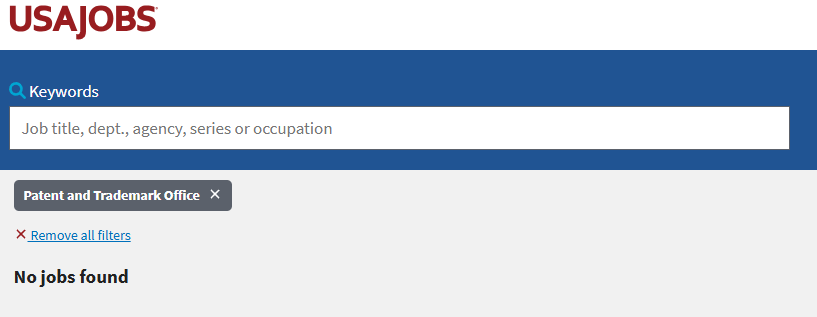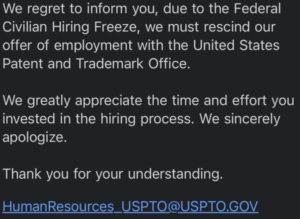by Dennis Crouch
It is tough that one of the very first acts of new USPTO Director Coke Morgan Stewart’s was to cancel hiring for the agency. Two weeks ago I saw a notice that the USPTO expected to hire over 800 new examiners during 2025 in an attempt to address the ever growing backlog of unexamined patent applications. But, today the agency rescinded offers already given and cancelled its job ads. Although unclear, examiners still in their first year probationary period may also be let go. What we have here is the patent office being caught up in the larger political theatre with real world consequences — directly for those individuals losing promised employment and more generally for the intellectual property system as a whole.
This is the first time I have ever searched USAJobs and found nothing for the USPTO.

1. A system comprising:
a memory that stores instructions; and
one or more processors configured by the instructions to perform operations comprising:
causing presentation, at a first user device associated with a first user of an interaction system, of a prompt selection interface of an interaction application provided by the interaction system, the interaction application enabling the first user to obtain automatically generated images and to interact with at least a second user of the interaction system;
receiving, from the first user device and via the prompt selection interface of the interaction application, an image generation request comprising a text prompt;
responsive to receiving the image generation request via the prompt selection interface of the interaction application, generating, via an automated text-to-image generator associated with the interaction system and based on the text prompt, an image;
causing presentation, at the first user device, of the image in an image selection interface of the interaction application;
receiving, from the first user device and via the image selection interface of the interaction application, an indication of user input to select the image; and responsive to receiving the indication of the user input to select, via the image selection interface of the interaction application, the image generated via the automated text-to-image generator: modifying, using the selected image generated via the automated text-to-image generator, a user image that is associated with the first user within the interaction system, and enabling the second user of the interaction system to be presented with the modified user image via the interaction application.

Let’s take a look at USPTO’s treatment of these two Snap’s applications.
US Patent No. 12,205,207 was assigned to a “harder” examiner with a 58% three year allowance rate in an art unit averaging a 73% allowance rate. Stats provided by Patent Bots.
Unlike those Chinese filed patent applications that, following a speedy, thin examination based on CNIPA’s Chinese language documents, are essentially rubber-stamped allowances, in Snap’s applications, both this examiner and applicant cited scads of prior art, with the vast majority written in the English language.
The 18 page first Office action contained an extensive 103 rejection which Snap overcame by amendment and argument.
In contrast, US Patent No 12,204,163’s prosecution history illustrates the concept of cherrypicking.
This application was assigned to an art unit with a 81% average three year allowance rate and docketed to a “very easy” examiner with a 92% allowance rate. Docketed August 24, 2024 and allowed Sept 10, 2024.
As a continuation of two allowed patents, the reasons for allowance copy much of claim 1 and provide no distinguishing of the claims over any piece of prior art.
The examiners’ comments actually contain embedded reviewer’s instructions “to show me a reference that discloses some of the limitations to that of the claimed invention.”
No double patenting rejection was made over the claims in the two parent applications. Nor did the examiner provide reasons why these claims are patentable distinct from the two parent patents. Applicants did not file a Terminal Disclaimer. How did this get past quality review?
Meanwhile, this same examiner has not examined the following applications on their docket:
US SN 17/730,236, filed April 27, 2022 by Coopervision International Ltd of Fareham, Great Britain
US SN 17/733,816, filed April 29, 2022 by Dirk Doberman of Weimar, Germany
US SN 17/775,950, filed May 10, 2022 by Dreamers holding, Inc of Brooklyn, NY
US SN 17/779,758, filed May 25, 2022 by Shamir Optical Industry Ltd of Kibbutz Shamir, Israel.
US SN 17/798,838 filed August 10, 2022 by Circle Optics, Inc of Rochester, NY
US SN 17/814,652 filed July 25, 2022 by GM Global Technology Operations LLC of Detroit, MI
US SN 17/994,820 filed Nov. 28, 2022 by Corning Inc. of Corning, NY
Etc. etc.
Instead of working on any of these longer pending applications, the examiner apparently cherrypicked Snap’s application filed February 4, 2024 for a quick notice of allowance.
Moving forward, lets hope the new Director
(1) puts a stop to cherry picking
(2) addressed inconsistencies in art unit allowance rates
(3) requires quality shop to review first action allowances and
(4) requires examiners to address non-statutory double patenting requirements in made in continuing applications
A very good analysis. It sort of makes my point with using AI in the USPTO. With 1000s of examiners at work, AI would monitor progress and provide a KPI report to management as to when what you’ve outlined is occurring and elevate it for a discussion between examiner and management. Expediting actions is wished for but speedy determination without adequate examination is not what is wanted. China rubber stamps so many patents and then floods the USPTO for examination, making it difficult for everyone. How about setting up a separate area of the USPTO for foreign patents and have non-biased examiners working on US inventions. If we continuously make it harder and harder and more expensive for US inventors its going to reduce the filing of patents by US inventors. I don’t think this is what we want. We have to address the overload by China on our system.
Yes, the “luck of the draw” of examiners, now sometimes aided by allowance % data and clever claim 1 drafting, can make a big difference.
But as “a continuation of two issued patents” application, it’s original and true filing date may well be earlier than those later-filed applications on the examiners docket. Thus, in a normal and logical legal docket control system, properly entitled to be picked up to work on first.
The backlog of patent filing will likely grow if the USPTO system remains at its current staffing.
Can the injection of AI tools lead to more expedient review and response to inventors?
I’m using AI now to review large numbers of published patents and applications against a concept invention, and it is doing an excellent job of evaluating potential overlap of other’s published work.
I’m a relative novice at creating custom AI apps and I’ve achieved a fairly useful tool. I can only imagine what some professional AI programmers could offer the USPTO to improve its work output.
Are you an advocate of AI in USPTO?
I understand the PTO is already using some AI searches? Outside the PTO, if there is an AI system available in which its database is limited to patents and technical publications it would seem obvious if not essential to use it when needed, especially for the more extensive and important prior art searchs often conducted for an IPR petition, licensing, pre-litigation or ligation defense? [Not that I would trust using the cite hits obtained without checking them for accuracy.]